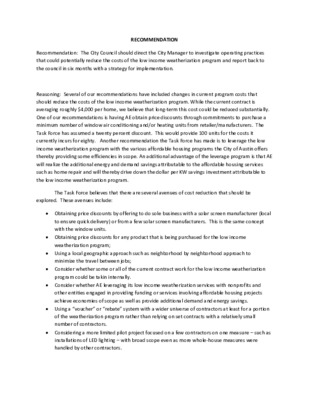Item 3a-Recommendation to Investigate Reducing the Costs of the Low Income Weatherization Program_Cyrus Reed — original pdf
Backup

RECOMMENDATION Recommendation: The City Council should direct the City Manager to investigate operating practices that could potentially reduce the costs of the low income weatherization program and report back to the council in six months with a strategy for implementation. Reasoning: Several of our recommendations have included changes in current program costs that should reduce the costs of the low income weatherization program. While the current contract is averaging roughly $4,000 per home, we believe that long-term this cost could be reduced substantially. One of our recommendations is having AE obtain price discounts through commitments to purchase a minimum number of window air conditioning and/or heating units from retailer/manufacturers. The Task Force has assumed a twenty percent discount. This would provide 100 units for the costs it currently incurs for eighty. Another recommendation the Task Force has made is to leverage the low income weatherization program with the various affordable housing programs the City of Austin offers thereby providing some efficiencies in scope. An additional advantage of the leverage program is that AE will realize the additional energy and demand savings attributable to the affordable housing services such as home repair and will thereby drive down the dollar per KW savings investment attributable to the low income weatherization program. The Task Force believes that there are several avenues of cost reduction that should be explored. These avenues include: Obtaining price discounts by offering to do sole business with a solar screen manufacturer (local to ensure quick delivery) or from a few solar screen manufacturers. This is the same concept with the window units. Obtaining price discounts for any product that is being purchased for the low income weatherization program; Using a local geographic approach such as neighborhood by neighborhood approach to minimize the travel between jobs; Consider whether some or all of the current contract work for the low income weatherization program could be takin internally. Consider whether AE leveraging its low income weatherization services with nonprofits and other entities engaged in providing funding or services involving affordable housing projects achieve economies of scope as well as provide additional demand and energy savings. Using a “voucher” or “rebate” system with a wider universe of contractors at least for a portion of the weatherization program rather than relying on set contracts with a relatively small number of contractors. Considering a more limited pilot project focused on a few contractors on one measure – such as installations of LED lighting – with broad scope even as more whole-house measures were handled by other contractors.